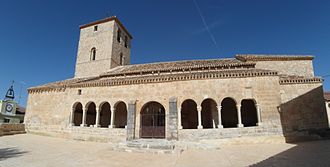Miño de San Esteban
| Miño de San Esteban municipality | ||
|---|---|---|
 Miño de San Esteban - the village with the Church of San Martín
|
||
| coat of arms | Map of Spain | |
 Help on coat of arms |
|
|
| Basic data | ||
| Autonomous Community : |
|
|
| Province : | Soria | |
| Comarca : | Tierras del Burgo | |
| Coordinates | 41 ° 32 ′ N , 3 ° 21 ′ W | |
| Height : | 960 msnm | |
| Area : | 48.89 km² | |
| Residents : | 46 (Jan 1, 2019) | |
| Population density : | 0.94 inhabitants / km² | |
| Postal code : | 42328 | |
| Municipality number ( INE ): | 42116 | |
| administration | ||
| Website : | Miño de San Esteban | |
Miño de San Esteban is a small mountain village and at the same time the center of a municipality ( municipio ) with only 46 inhabitants (as of January 1, 2019) in the Spanish province of Soria in the autonomous community of Castile-León . The place belongs to the poorly populated Serranía Celtibérica and is located on the Camino del Cid .
Location and climate
The place Miño de San Esteban is located in the rather barren hilly landscape in the west of the Soria province about 5 km south of the Duero at an altitude of about 960 m . The distance to the provincial capital Soria is almost 85 km (driving distance) in a north-easterly direction; the nearest town, Burgo de Osma , is around 25 km away. The climate is temperate to warm; the rather sparse rain (approx. 490 mm / year) falls over the year.
Population development
| year | 1857 | 1900 | 1950 | 2000 | 2017 |
| Residents | 367 | 431 | 409 | 94 | 48 |
The mechanization of agriculture , the abandonment of small farms and the increasing aridity of the mountain region led to a loss of jobs, which triggered a rural exodus since the 1950s .
economy
With the exception of barley , hardly any grain was possible to grow on the barren soils of the cold plateaus of the Soria province . For centuries, the population lived from breeding sheep and goats, whose milk was used to make cheese, which after laborious transport could be sold at the market in Burgo de Osma or exchanged for flour, etc. The wool of the sheep was spun and in winter it was woven into lengths of fabric from which simple clothing was made. Goat hair was partially suitable for the production of weatherproof throws (ponchos) or sacks, ropes, etc. Today the rental of holiday homes (casas rurales) is the most important source of income for the community alongside agriculture.
history
Celts , Romans , Visigoths and even the Moors left no archaeologically usable traces; It was probably hunters and shepherds who first penetrated the mountain region and used it as summer pasture. The verifiable history of the place begins with its Romanesque church.
Attractions
The Iglesia de San Martín , originally built from rubble stones , is dedicated to St. Consecrated to Martin of Tours . Like many churches in the region, it was later expanded to include a south porch ( portico ) and a bell tower (campanario) made of precisely hewn stones. The Romanesque portal protected by the vestibule is of great decorative diversity; The green stone inlays in one of the archivolts are particularly noteworthy . In the nave (nature) to find Gothic frescoes remnants of 13/14. Century; in one corner there is a Romanesque font (pila bautismal) .
Web links
Individual evidence
- ↑ Cifras oficiales de población resultantes de la revisión del Padrón municipal a 1 de enero . Population statistics from the Instituto Nacional de Estadística (population update).
- ↑ Miño de San Esteban - Camino del Cid
- ↑ Miño de San Esteban - Climate tables
- ↑ Miño de San Esteban - Population Development
- ↑ Miño de San Esteban - Church
- ↑ Miño de San Esteban - Church

